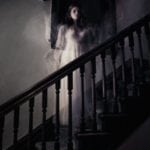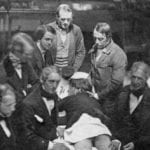 Weird Stuff
Weird Stuff  Weird Stuff
Weird Stuff  Our World
Our World 10 Ways Your Christmas Tree Is More Lit Than You Think
 Movies and TV
Movies and TV The 10 Coolest Stars to Set Sail on The Love Boat
 History
History 10 Things You Didn’t Know About the American National Anthem
 Technology
Technology Top 10 Everyday Tech Buzzwords That Hide a Darker Past
 Humans
Humans 10 Everyday Human Behaviors That Are Actually Survival Instincts
 Animals
Animals 10 Animals That Humiliated and Harmed Historical Leaders
 History
History 10 Most Influential Protests in Modern History
 Creepy
Creepy 10 More Representations of Death from Myth, Legend, and Folktale
 Technology
Technology 10 Scientific Breakthroughs of 2025 That’ll Change Everything
 Weird Stuff
Weird Stuff Ten Bizarre Facts About The Doge Meme
 Our World
Our World 10 Ways Your Christmas Tree Is More Lit Than You Think
 Movies and TV
Movies and TV The 10 Coolest Stars to Set Sail on The Love Boat
Who's Behind Listverse?

Jamie Frater
Head Editor
Jamie founded Listverse due to an insatiable desire to share fascinating, obscure, and bizarre facts. He has been a guest speaker on numerous national radio and television stations and is a five time published author.
More About Us History
History 10 Things You Didn’t Know About the American National Anthem
 Technology
Technology Top 10 Everyday Tech Buzzwords That Hide a Darker Past
 Humans
Humans 10 Everyday Human Behaviors That Are Actually Survival Instincts
 Animals
Animals 10 Animals That Humiliated and Harmed Historical Leaders
 History
History 10 Most Influential Protests in Modern History
 Creepy
Creepy 10 More Representations of Death from Myth, Legend, and Folktale
 Technology
Technology 10 Scientific Breakthroughs of 2025 That’ll Change Everything
10 Gruesome Murder Sites That Attract Tourists Like Flies
Lizzie Borden was acquitted of the 1892 murder of her father and stepmother in their Fall River, Massachusetts, home. Folklore, however, has judged her guilty. Who can forget the nasty schoolyard jingle the case inspired?
Lizzie Borden took an ax
Gave her mother forty whacks
When she saw what she had done
She gave her father forty-one
These days folks are no longer hesitant to cash in on things morbid and macabre, and Lizzie Borden has become Fall River’s chief tourist attraction. There are tours that visit Lizzie’s grave and the courthouse where she stood trial. Gift shops sell Lizzie Borden bobblehead dolls. As for the Borden house, it is now a homey bed and breakfast, where you can spend the night in the room where Lizzie’s stepmother got the Big Chop, or sit on a sofa similar to the one on which her father’s body was found.
Fall River is not the only locality cashing in on bloodshed. So-called “dark tourism” is booming. Across the country, and around the world, folks are lining up to visit the sites of executions, ax murders, gun fights, and mob wackings. If you would like to see some homicide scenes yourself, here is a list of ten gore-splattered destinations.
10Salem Village

In the late 1600s, the Devil stalked colonial Massachusetts. At that time, people in Europe still believed in witchcraft, and accused witches were often put to death. The settlers of Salem Village, mostly members of the Puritan religious sect, brought those beliefs with them when they left England for the New World.
All that led to one of the strangest and ugliest episodes in American history—the Salem Witch Trials. In 1692 the village hanged 19 people who had been accused of witchcraft by hysterical teenage girls. Another victim, 80-year-old Giles Corey, was crushed to death beneath a pile of rocks. Shortly after that, the colonial governor stepped in and restored sanity. He pardoned all those still locked up and dissolved the witch trial court.
For a long time—centuries—folks in Salem seldom spoke about the state-sanctioned homicides. American artists and writers, however, seized on the witch trials as an allegory for intolerance. Then, in 1992, the 300th anniversary of the tragedy, the city erected a somber memorial,[1] a park with 20 granite benches, one for each of the 20 victims.
Such sobriety did not last long, however. Today, Salem promotes itself as “the Witch City,” though there is no proof anyone actually practiced witchcraft there in colonial times. You will find the streets jammed with tacky tourist attractions built around the witchy theme, including fortune-telling salons, occult shops, haunted houses, and wax museums. Many of the proprietors claim to be witches themselves. There is even a bronze statue of a broom-riding Elizabeth Montgomery, star of the TV sitcom Bewitched. The entire month of October is given over to Halloween parades, costume parties, and Mardi Gras-style revelry.
9Tombstone’s OK Corral

Every fan of western movies is familiar with the scene. On October 26, 1881, gunfighter Wyatt Earp, his brothers Virgil and Morgan, and their sidekick Doc Holliday sauntered down the main drag in Tombstone, Arizona. All were heavily armed and heading toward the OK Corral. There they confronted a group of young cowboys with whom they had a long feud. It is still debated who fired the first shot, but when the gunsmoke cleared, three of the cowboys were dead. Morgan Earp, Virgil Earp, and Doc Holliday all suffered minor wounds, but Wyatt, not so much as a scratch.
In 1880s Tombstone, opinion was split as to whether the killings were justified. Virgil Earp was the town Marshall, and supporters said he was upholding the law. Others saw the Earps as bloodthirsty bullies. At the wake for the three dead cowboys, a sign was posted reading “MURDERED IN THE STREETS OF TOMBSTONE.”
Hollywood, however, has since made Wyatt Earp a hero. The shootout has been immortalized in numerous films, including Frontier Marshal (1939), My Darling Clementine (1946), Gunfight at the OK Corral (1957), Tombstone (1993), and Wyatt Earp (1994).
The silver mines that made Tombstone an 1880s boomtown are long gone today. The chief industry in the town of 1,600 is now tourism, built around the burg’s past reputation for violence and bloodshed. The website for the local Chamber of Commerce urges visitors to see gunfight recreations (the players shoot blanks), OK Corral, Boothill Graveyard (they all died with their boots on), and the once-scandalous (but now G-rated) Bird Cage Theater.[2]
There is even a Wyatt Earp Vendetta Ride, which takes tourists on a five-day trek on horseback. It follows Wyatt Earp’s route when he led a posse hunting those who sought revenge after the OK Corral gunfight. Happy trails!
8Hatfield-McCoy Country

When people think of feuds, what often comes to mind is the 30-year war between the Hatfields and the McCoys, two mountain clans living alongside Appalachia’s Tug River. The McCoys lived on the Kentucky side, while West Virginia was home turf to the Hatfields. By the time government officials established a truce in 1891, more than two dozen people had died, including women and children.
You might think folks living in that region now would want to forget their forefather’s barbaric behavior, but you would be wrong. Local tourism officials—along with members of the now reconciled Hatfield and McCoy clans—are working to bring tourists to fight scenes in the mountain region. Visit an old Hatfield cemetery today, and you are likely to meet a gaggle of out-of-staters searching for the graves of celebrated feud victims.
Congress recently appropriated $500,000 to make old feud sites more visitor-friendly, and Kentucky’s state government kicked in another $100,000.[3] Promoters have launched websites and brochures and a national advertising campaign, which has included ads in O, The Oprah Magazine.
“The Hatfields and McCoys can be a real boon to this area,” Ron McCoy, a McCoy descendent and Kentucky state official, recently told The New York Times.
At the overgrown Hatfield Cemetery stands a life-size statue carved from Italian marble depicting William Anderson Hatfield—better known as Devil Anse—psycho-patriarch of the Hatfield clan. Other feud players from both sides are also buried here, including mountain mack daddy Johnse Hatfield, who put aside the feud long enough to get Rosanna McCoy pregnant, and then court and marry Nancy McCoy.
In McKarr, Kentucky, visit the scene of the “Pawpaw Massacre,” where Devil Anse ordered his kin to tie three captive McCoy boys to pawpaw trees and open fire. Just don’t expect to see trees; locals say pawpaws will no longer grow on the blood-stained ground.
The Hog Trial Cabin is one of the most popular stops on the tour. It is where Randall McCoy sued Floyd Hatfield over a stolen pig. The trial ended in Hatfield’s favor, thanks to the vote of a McCoy in-law on the jury who refused to take the family’s side. (Afterward, his kin-by-marriage shunned him, and later they shot him.) The episode is said to have sparked the killings that followed.
In Blackberry, Kentucky, stop at the scene of the New Year’s Eve Massacre. On December 31, 1888, a gang of drunk Hatfield raiders set fire to Randall McCoy’s cabin and opened fire on his fleeing family. They killed Randall’s daughter and son, and beat his wife Sarah near to death.
A well and an outline of the cabin still exist. Archeologists sponsored by National Geographic recently dug at the cabin site. They found bullets fired by the Hatfields which are now displayed at the Pike County Museum.
7London’s East End

In the early morning hours of August 31, 1888, a deliveryman working in London’s slummy Whitechapel district made a ghastly discovery: the body of prostitute Mary Ann Nichols lay in the street, with her abdomen torn open by a long jagged wound. Thus began the one of history’s most famous police investigations, the hunt to catch Jack the Ripper, whose identity is still unknown.
Most researchers agree the killer claimed at least five victims—all prostitutes—between 1888 and 1891. Some credit 11 deaths to the slayer. Victorian-era police never charged anyone, but armchair detectives—dubbed “ripperologists”—have generated a long list of suspects, including a nephew of Queen Victoria.
Police received scores of macabre letters allegedly penned by the killer. One package contained half a human kidney pickled in wine. Another included the lines “I am down on whores and I shant quit ripping them till I do get buckled.” The missive was signed “Jack the Ripper,” the origin of the monster’s moniker.
Today, tourists flock to London’s East End (no longer a slum) to view the murder scenes. There are Jack the Ripper walking tours that lead visitors down a labyrinth of narrow lanes and cobblestone alleys and stop by a doorway where the killer may have chalked graffiti. They hoist pints at Ten Bells Pub, an ancient tavern where several victims—and perhaps the killer—were regular customers.[4] The gruesome letters sent to police are sometimes displayed in London museums.
Many of the East End buildings from the 1880s still stand. All that is missing from the scene are the slummy atmosphere and the streetwalkers.
6Villisca Murder House

On the morning of June 8, 1912, in sleepy Villisca, Iowa, a nosy housewife took note that no one in the Moore family had stepped outside to feed their chickens. By 8:00 a.m., she had become concerned, and telephoned a Moore relative. He arrived and entered the house. He came out looking shaken and telephoned the police.
Marshall Hank Horton was the next to go inside. When he emerged, he announced he had found “somebody murdered in every bed.”
The eight victims were: Josiah B. Moore, 43; his wife, Sarah Moore, 39; their four children, all between the ages of five and 11; and two neighbor children who were sleep-over guests. All had been bludgeoned with an ax.
Despite a ten-year investigation, the murders were never solved, though there were many suspects. Investigators looked at Moore’s business rivals and the family of a young woman rumored to be his adulterous lover. Others pointed fingers at Lyn Kelly, an itinerant preacher rumored to have mental problems. He confessed, but later recanted. A grand jury failed to indict him.
A 2012 article in Smithsonian Magazine suggested a serial killer had visited the Moore house. The article noted similarities to ten ax murders that occurred in 1911 and 1912. All took place in towns along rail lines between Illinois and Washington state.
Curiosity seekers have flocked to the Moore’s rustic homestead ever since. In 1994, entrepreneur Martha Linn purchased the property and removed all modern plumbing and electrical wires to restore the house to its 1912 condition.[5] A sign reading “Villisca Ax Murder House” stands in the front yard. There is an outhouse in the back. For $10, visitors can tour the premises; for $428, a group of six can spend the night. The guests come carrying ouija boards to contact spirits and electronic gear to record apparitions.
It is not all fun and games: in 2014, a visitor doing a paranormal investigation somehow suffered a self-inflicted stab wound. Fortunately, he recovered. Others may not be so lucky.
5Ma Barker’s House

Though the early 1930s, the Barker gang terrorized the Midwest. They swept up some $2 million through bank holdups and extortion kidnappings, and they were credited with ten homicides. The mastermind, according to some, was a middle-aged matron, Kate “Ma” Barker. Hollywood has painted her as a cigar-chomping, tommy-gun-toting matriarch who planned the heists. She allegedly gave the orders to her four sons—Herman, Lloyd, Arthur (known as “Doc”), and Fred—and their pal Al Karpis.
In early January 1935, FBI agents raided a Chicago apartment believed to be a gang hideout. Inside they found Doc Barker burning a stack of papers. Among the singed scraps agents discovered part of a letter from other gang members, informing Doc they had found a more comfortable refuge down south. The author wrote they were amusing themselves hunting for a giant three-legged alligator nicknamed Old Joe.[6]
Working with that clue, the FBI concentrated their manhunt on Georgia, Florida, and Louisiana. Just a few days later they learned Ma and Fred were ensconced in a two-story vacation home on the shores of Lake Weir in Oklawaha, Florida.
More than a dozen agents and local police descended on the property. “Surrender, Ma,” the posse leader called out. Fred Barker replied with a machine gun fusillade from a second-story window. In the four-hour gunfight that followed, the posse pumped more than 2,000 rounds into the house. When FBI agents finally dared enter, they found both Ma and Fred dead on the floor.
The landlord’s family continued to own the Lake Weir home for the next eight decades. In recent years, they graciously accommodated the curious by allowing the local chamber of commerce to hold a “Ma Barker Day” fundraiser, complete with a recreation of the shootout (using blanks, of course). On that day thousands also toured the interior of the house, gawking at bullet holes that still remain in the walls.
In 2016 the owners sold the land but donated the house to Marion County. In October a contractor floated the structure across the lake to a park on Carney Island, where it will be turned into a museum. Local planners hope the attraction will boost the region’s tourism economy.
Some say Ma still haunts the property. A retired police officer who visited the house told the New York Post he heard a female ghost growl “Get outta here, lawman!” And by the way, these days most historians doubt she had anything to do with her sons’ criminal activities. She simply cooked their meals.
4Dealey Plaza, Dallas

Dealey Plaza in Dallas, Texas, is one of the world’s most infamous locations. On November 22, 1963, John F. Kennedy and his wife Jacqueline were traveling through the park in an open-top Lincoln convertible when a sniper’s shot killed the 46-year-old president.
Police arrested Lee Harvey Oswald, a young ex-Marine with Communist sympathies who worked in the Texas School Book Depository. Investigators theorized Oswald had fired a rifle through a window on the building’s sixth-floor.
Two days later Oswald was himself shot and killed by vigilante Jack Ruby. That act helped cast doubt on the conclusion of the government’s investigatory panel that Oswald acted alone. Conspiracy theorists point to everyone from Fidel Castro to the Mafia to the CIA. That speculation has helped make Dealey Plaza one of the top tourist destinations in the state of Texas.
In the decades since the assassination, there have been few physical changes to the area surrounding Dealey Plaza. For a long time, a small plaque was the only physical marker informing visitors they had reached the scene of the tragedy. The city’s official Kennedy memorial—a large cenotaph—is more than a block away on Main Street.[7] Visitors came all the same—tens of thousands every year—and before long Dealey Plaza became a bustling tourist trap.
Vendors and self-proclaimed tour guards prowl the plaza. They have painted a white X in the street to mark the spot where Kennedy was hit by bullets. Some are conspiracy buffs hawking books and DVD documentaries. Others are homeless people who deliver memorized recitations for a handout. One enterprising Dallas resident has parked a Lincoln Continental—decorated with American flags—by a corner. He calls it a “replica” of the presidential limo and requests a $5 donation from visitors who snap pictures. A couple of tour buses are parked in the area, too. They are owned by fiercely-competitive businessmen who sometimes face off in court to settle confrontations on the plaza.
In 1989 a non-profit group transformed a portion of the nearby Texas School Book Depository into a museum. Officially the focus is on Kennedy’s achievements, but those looking for something ghoulish find it. At a sixth floor window overlooking Dealey Plaza, book boxes are stacked to recreate Oswald’s sniper perch. Videos for sale at the museum gift shop include the Zapruder film, a home movie of the assassination that happened to catch blood spurting from the president’s head as the bullet struck. So much for tasteful remembrance.
3Umberto’s Clam House

When Joe Gallo swaggered into Umberto’s Clam House in the early morning of April 7, 1972, our guess is the manager had a wide smile on his face. In New York City’s Little Italy, when mobsters patronize your restaurant, it means the food is tops.
And in the 1970s, Crazy Joe (as the tabloids tagged him) was the city’s most-talked-about criminal, but more for his atypical lifestyle than his problems with the law. Charming and flamboyant, Gallo made his home in Greenwich Village, read Satre and Camus, and socialized with the city’s artists, actors, and authors. His friends included Hollywood star Jerry Orbach and rock balladeer Bob Dylan, and he inspired a novel by Jimmy Breslin. When he went out to party, his celebrity friends often tagged along.
On this particular night, Gallo was celebrating his 43rd birthday with his sister, his wife, and his stepdaughter. They sat down at a butcher-block table and ordered mussels, calamari, and scungilli. A couple of bodyguards found seats in another corner of the room.
The party was just getting started when four men walked in through a side door and opened fire with revolvers. Then they calmly walked out, stepping into a waiting getaway car parked on Mulberry Street.
Gallo was hit five times. He stood up and staggered toward the door, perhaps to draw gunfire away from his family. Gallo crashed through the entranceway’s plate glass, staggered into the street, and fell down dead. No one has ever been charged with his murder.
More than four decades later, Umberto’s is still famous for the Mafia hit. Never mind that the restaurant long ago moved two blocks, from Mulberry and Hester Streets to Mulberry and Broome. These days, tour guides leading visitors through Little Italy stop near the spot where Gallo hit the ground and relate the story.[8] And on Fodor’s website, the curious ask if bullet holes can still be seen. (They are still there, on the doorway of a tenement across from Umberto’s original location.)
Owner Robert Ianniello once told the New York Times he gets calls once or twice a month from producers who want to use the restaurant in TV shows. He always tells them “No.” Ianniello, whose father launched the restaurant just a month before the hit, says he is unhappy with the mob references because “it gives you an unwanted reputation.” But he was quick to add the notoriety does bring in customers, and many return because they enjoy the zesty eats.
2Jeffrey Dahmer’s Milwaukee

Jeffrey Dahmer was one of America’s most notorious serial killers, a man whose crimes haunt our nightmares to this day. He stalked the gay bars of Milwaukee, looking for victims he could lure back to his apartment. Those who followed him to his lair were first drugged, then murdered. Dahmer performed sex acts on the corpses and mutilated them. He kept body parts as souvenirs, and sometimes for snacks. That’s right; he was a cannibal.
Arrested in 1991, he confessed to killing at least 17 people. In 1994 Dahmer himself was murdered by a fellow prison inmate.
You might think people would want to leave that horrific episode in the past. Guess again. The public has always been fascinated with serial killers. The Dahmer case has inspired movies, books, trading cards, and even a graphic novel (My Friend Dahmer by Derf Backderf).
And in 2012 a company called BAM Marketing and Media announced the launch of a Dahmer Tour, which would lead the curious to the killer’s old haunts in Milwaukee’s Walkers Point neighborhood. For a $10 ticket, according to the company’s online promotion, those on the walking tour “would find a trail he forged, time and again in his last years, hunting, pacing, preying, and eventually luring his victims into his sickening mad world.”
The promotion failed to mention that the neighborhood was gentrified in the early ’90s, that Dahmer’s apartment building has been demolished and the bars he frequented closed. What’s more, the announcement of the tour business sparked a storm of protests from relatives of the victims and those living in the neighborhood. The tour company sought to make amends by offering a donation to the National Organization of Parents of Murdered Children, but the charity refused the cash.[9]
Others have avoided exploiting the tragedy. When Dahmer’s boyhood Ohio home went on the market in 2014, the real estate agency nixed the usual open house, announcing instead that only serious buyers could view the property.
1John D. Long Lake

On October 15, 1994, in Union, South Carolina, a frantic young woman stood at the door of a house on Highway 49 and hysterically yelled for someone to call 911. Moments later, Susan Smith was telling officers a black man had hijacked her car, and he had taken off with her two boys in the back seat.
The heartbreaking story gripped the nation and fanned racial tensions. For the next nine days, television viewers across the country watched Smith tearfully beg for the return of her sons, Michael, age three, and Alexander, 14 months. Then, under questioning from skeptical detectives, she broke down and spoke the truth: her children were not missing; they were dead. Smith told how she strapped them into their car seats, drove to John D. Long Lake, stepped out of the car, and let it roll into the murky waters with the boys inside.
The motive: Her marriage was breaking up, and she hoped to pursue a relationship with a wealthy man who had told her he did not want kids in his life.
The next year Smith was sentenced to life in prison. She will be eligible for parole in 2025. Recently she penned a note to a reporter, claiming she is “not the monster society thinks I am,” and that “something went very wrong that night.”
Long Lake, meanwhile, has become a place of pilgrimage. The man-made pond, with a shoreline shrouded by kudzu, was originally constructed to be a place where fishermen could troll for bass, bluegill, and catfish. These days, though, the sportsmen are joined by tourists. The visitors leave flowers, toys, poems, and other trinkets near a granite monument to the two boys.
Unfortunately, the story does not end there. Two years after the Smith tragedy, the lake claimed seven more lives.
On a Saturday night in September 1996, two families climbed into a Chevrolet Suburban and drove to the lake to view the memorial. They parked on the ramp. Most of the adults stepped out of the car for a better view. Tim Phillips stayed in the driver’s seat to keep an eye on the four toddlers riding in the back.
Somehow—for reasons still unexplained—the SUV began to roll. Tim Phillips’s wife Angie and friend Carl White jumped in the water, hoping to free the children, but drowned themselves.[10]
Police believe the second drowning incident was accidental. They theorize Tim Phillips stepped outside the car to answer the call of nature, and then the car began rolling. He jumped back in the driver’s seat, but with his pants unzipped, he was too slow to stop the vehicle.
“It’s like it’s haunted,” one local man told The Associated Press. “It keeps taking lives.”
Stink Bedard has foresworn hygiene as a social protest.
Read more about fascinating tourist destinations on 10 Of The World’s Deadliest Tourist Destinations and 10 Fascinating Proposed Tourist Traps.








